FEATURE | By Mark Lewis
Ojai at the Crossroads

Just as in 1947, Ojai faces tough challenges, which may well define this community through the end of the 21st century.
75 years ago, in the wake of World War II, the people of the Ojai Valley faced several enormously consequential decisions that would profoundly shape the community we know today. They decided to bet big, and as a result, in that extraordinary spring of 1947, both the Ojai Valley Inn and the Ojai Music Festival were born, while the Ojai Valley Tennis Tournament sprang back to life after a five-year wartime hiatus that might very easily have become permanent. Imagine Ojai today without these three institutions, each of which connects us with the wider world while allowing us to maintain a separate, small-town existence.
Now, in the (possibly, hopefully, tentatively) post-Covid spring of 2022, this community again faces a fateful decision about its future. This time, the question before us is whether we’ve become perhaps a little too interconnected with the wider world, and if so, what should we do about it. The answer may well determine whether Ojai can preserve its delicate balance as a small-town Shangri-La respectfully supported by big-city tourists — or whether we soon pass the tipping point into a future as a beautiful but artificial stage set for visitors who don’t even notice whether a genuine, authentic local community still endures here, behind the lovely natural scenery and the tourist-friendly amenities.
As the community grapples with this issue, the Ojai Valley Museum is preparing an exhibit — “Ojai At The Crossroads,” opening April 1 — that revisits the epochal events of spring 1947. The exhibit will celebrate the 75th anniversaries of the Inn and the Music Festival and of the Tennis Tournament’s return, and it will remind museum-goers that we once again stand at a crossroads in this potentially epochal spring of 2022.
Arguably, we got it right in 1947. Can we get it right today?
ROAD TO OJAI
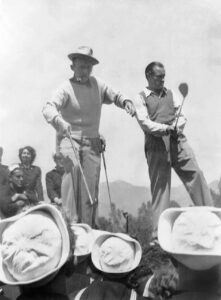
Bing Crosby and Bob Hope, promoting one of their “Road To” films, played an exhibition in Ojai, which helped spur interest in reviving the moribund Ojai Country Club golf course.
World War II was winding down in April 1945, when Bob Hope and Bing Crosby came to Ojai to play a round of golf to benefit a Navy charity. The two film stars were gearing up to promote their latest picture together, “Road to Utopia,” in which they played two vaudeville grifters trying to strike it rich during the Klondike Gold Rush. In Ojai, they kept the crowd laughing with the back-and-forth banter they had perfected in their popular “road” films, of which “Utopia” would be the fourth installment.
The match took place on a nine-hole course that was all that was left of the Ojai Valley Country Club links laid out two decades earlier by the famous designer George C. Thomas, Jr. The other nine holes were hidden under a village of Quonset huts and barracks buildings put up by the Army in 1942, when the former golf club had been converted into a training facility in the wake of Pearl Harbor. After the Army pulled out in 1944, the Navy moved in and operated Camp Oak as an auxiliary facility for sailors based at Point Mugu and Port Hueneme. Many of those sailors were on hand to cheer as Hope and his serviceman partner beat Crosby and his partner by a single stroke.
The golf course owed its existence to the philanthropist Edward Libbey’s plan to transform Ojai’s Arbolada and West Hills neighborhoods into an upscale enclave of Spanish-style mansions. Their owners naturally would need a place to play golf and socialize together over cocktails, so Libbey created an adjacent country club, which opened in 1924. In time, he planned to add a swanky hotel that would turn the club into a full-fledged resort. Those plans were still on the drawing board when he died in 1925, and the advent of the Great Depression rendered them moot.
The trustees of Libbey’s estate were based in Toledo, Ohio, and they managed his Ojai properties to benefit the Toledo Museum of Art, which Libbey had founded. The estate’s man in Ojai was Rawson B. Harmon, who maintained his office in the distinctive little building near the Ojai Library that these days houses the “Twice-Sold Tales” bookstore. Harmon’s main job was marketing building lots in the mostly empty Arbolada, a tough sell during the Depression. He loved Ojai and he particularly loved the Ojai Valley Country Club, and he refused to give up on it when hard times forced the Trust to close it in 1930.
Harmon evidently prevailed upon the trustees to double down on the club. It reopened it in 1935 with a new 25-room hotel next to the clubhouse, along with a dining room and a bar. This small resort was only open in the winter, and it struggled to attract guests during the Depression. Then came the war, and the Army and Navy took over for the duration. Now, in April 1945, the well-publicized Hope-Crosby match reminded everyone that underneath all those Quonset huts lay a first-class golf course. Which raised the question of what would become of the 200-acre property when the war ended.
That question was of particular interest to a local group of gentlemen ranchers and their wives who got together for regular poker parties. The group included the lawyer Charles Teague, a Limoneira heir and future Congressman, and his wife, Marge, of Hitching Post Ranch; Charles Raymond, an heir to the Goodrich tire fortune, and his wife, Valerie, of Ladera Ranch; Fanning and Ann Hearon of Running Ridge Ranch; the iron-ore mogul Clement Quinn of Twin Peaks Ranch; Robert Calder Davis, Sr. of Crooked Creek Ranch; and others. They were growers rather than developers, and they preferred Ojai as the rural paradise it was.
“They were the voice of agriculture in this community,” says Bob Davis, Jr., who remembers his father hosting poker parties in the family home on Gridley Road.
Most of these poker buddies were avid golfers, eager to bring back that classic George C. Thomas course. Those who didn’t play golf still valued the country club as a social hub. None wanted to see the property carved up into a new subdivision full of tract homes — which seemed its most likely fate when the Libbey estate announced in September 1945 that it planned to dispose of the property after the Navy pulled out. The poker players had a better idea: Bring the country club back to life, by expanding its small hotel into a full-fledged resort.
“The idea was, ‘Hey, boys, let’s put into this, and the hotel is going to pay for our golf,’ ” Bob Davis says.
The poker players had an ace in the hole: Rawson B. Harmon. He was a regular at their poker parties, and he was still the Libbey estate’s representative in Ojai, so he was perfectly positioned to orchestrate the desired outcome. Harmon originally had made his fortune developing subdivisions in Detroit during the 1920s boom, so he knew exactly how profitable those 200 acres would become during the coming postwar Southern California boom. But Harmon did not want to see his beloved Ojai golf course plowed under and reinvented as a bedroom suburb for Ventura. In 1916, he had co-founded Detroit’s storied Oakland Hills Country Club. The Ojai Valley Country Club was similarly a jewel, and Harmon did not intend to preside over its demise. In October 1946, he brokered its sale for a reported $450,000 to two groups of investors, one from Ojai and the other from Beverly Hills.
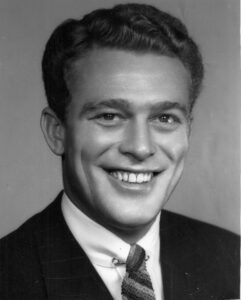
Hotelier Don B. Burger led the group of investors to build the Ojai Valley Inn in 1947. He also participated in the return of “The Ojai” and the founding of the Ojai Music Festival
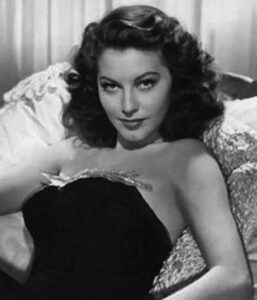
Ava Gardner was an investor and habitué of the Ojai Valley Inn.
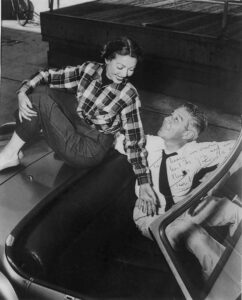
Loretta Young and her husband Tom Lewis were among the Hollywood luminaries who invested in the Ojai Valley Inn’s creation in 1947.
The Ojai contingent included Harmon himself, along with his poker buddies Chuck Teague, Charlie Raymond, Clem Quinn, and Bob Davis. (Other Ojai investors included their friend Louis Boyle of Orchidtown.) The Beverly Hills group included the film stars Loretta Young, Irene Dunne and Randolph Scott, and was led by a former Hilton Hotels executive named Don B. Burger, who would take managerial charge of the project. No one seems to recall who it was who first alerted Burger to this Ojai opportunity. It might have been Ojai’s own Scotty Chisholm, the well-connected golf journalist who had helped arrange the Hope-Crosby match. Whatever it was that brought Burger here, he arrived with a plan. The golf course would be restored to its former glory, and the little 25-room hotel would be transformed into a major resort, to be renamed the Ojai Valley Inn.
TENNIS, ANYONE?
Reviving the defunct country club was not Harmon’s only Ojai reclamation project. That Hope-Crosby match of 1945 took place on April 29, on a weekend usually monopolized by the venerable Ojai Valley Tennis Tournament – a.k.a. “The Ojai.” This tournament was a huge deal in the tennis world, and a cherished annual tradition in Ojai since 1896. Not merely a tournament, The Ojai was a three-day, valley-wide festival, and the social event of the season. But, due to wartime restrictions, it had gone on hiatus after the 1942 tournament, and its supporters feared it might never come back.
Nevertheless, they would not give it up without a fight. In The Ojai newspaper on Feb. 7, Harmon announced that he was chairing a finance committee “to secure funds for the reopening of the tennis tournament,” and that the committee would make “a communitywide appeal for support.” Other finance committee members included Harmon’s poker buddies Teague, Quinn, and Raymond, plus Lou Boyle and — tellingly — a brand-new Ojai resident: Don B. Burger. The same crowd that was bringing the country club back was also rallying to save “The Ojai.”
“The fate of the whole grand tradition of Ojai Valley tennis depends on whether or not we hold the tournament this year,” Irene Burns wrote in the newspaper on Feb. 11. “The powers that be in the Southern California Tennis Association have decreed that if the Ojai tournament is not held this year we will lose for all time our traditional dates — the last full weekend in April. Are we going to allow this to happen after half a century of annual tennis tournaments?”
In addition to needing money to fix up the courts, the Tennis Club desperately needed to find beds for the visiting players. The Foothills Hotel was no more — since 1942, its former building had housed the California Preparatory School. As for the Ojai Valley Inn, its new bungalows were still under construction. Ojai residents responded to the Tennis Club’s appeal by offering their spare bedrooms to house visitors. Soon, the Thacher School teacher and budding historian David Lavender, who was handling publicity for the tournament, was able to announce in The Ojai that “The Ojai” was back in business.
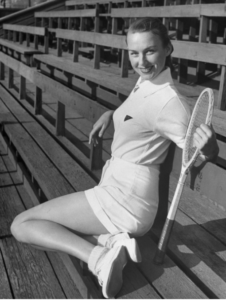 “It is always hard to pick up the threads after a four-year layoff, and there are those who hoped Ojai would not try, for other towns and clubs would like to divide among themselves its tradition-hallowed dates and events,” Lavender said. “But Ojai’s old-timers all jumped back into harness … They make the Ojai tournament an integral part of the whole community’s life. Perhaps that is why the meet has gripped the imagination and the interest of the town in a way difficult to explain to those who never saw and shared it. Certainly, it helps to account for Ojai’s uniqueness, its warmth and an intangible air of friendliness unmatched by any other large sports event in the country.”
“It is always hard to pick up the threads after a four-year layoff, and there are those who hoped Ojai would not try, for other towns and clubs would like to divide among themselves its tradition-hallowed dates and events,” Lavender said. “But Ojai’s old-timers all jumped back into harness … They make the Ojai tournament an integral part of the whole community’s life. Perhaps that is why the meet has gripped the imagination and the interest of the town in a way difficult to explain to those who never saw and shared it. Certainly, it helps to account for Ojai’s uniqueness, its warmth and an intangible air of friendliness unmatched by any other large sports event in the country.”
The spring of 1947 was not only about the return of tennis and golf. A major public controversy arose over the Matilija Dam, then under construction, when unstable clay was discovered oozing from under the partially built concrete foundation. But the county Board of Supervisors voted to complete the dam.
Meanwhile, on April 20, the Art Center and its folk-dancing maestro, David Young, held their second annual spring folk dance festival at Sarzotti Park. This was arguably Ojai’s biggest public event that spring, attracting 500 dancers and 1,000 spectators from across Southern California. Thanks to Young and his group, Ojai was beginning to make a name for itself as a cultural hot spot.
But ultimately it was a different impresario, with a different festival, who would put Ojai on the map of America’s cultural landscape. His name was John Bauer, and his timing seemed perfect, for just as he was gearing up to launch his project, the world beat a path to his door. An internationally renowned writer from Paris, the world capital of culture, arrived in Ojai to visit one of Bauer’s key collaborators.
THE SOUND OF MUSIC
Simone de Beauvoir slipped into Ojai via Creek Road in a little yellow car driven by her protégé Nathalie Sorokine Moffatt. The date was Feb. 28, 1947 — a Saturday, as it happens. The two women were heading for the East End home of Moffatt’s mother-in-law, where they would spend the night while en route to San Francisco. Beauvoir, the celebrated Existentialist writer, was on a lecture tour of the U.S., and she was taking notes along the way that she would turn into a book, “America Day By Day.”
“The valley we’ve entered offers just the kind of landscape you’d expect to find in California,” Beauvoir noted. “Enclosed by mountains on three sides, it opens wide on the fourth and descends toward the sea, which can be seen in the distance. This whole amphitheater is planted with orange trees, lined up as regularly as the trees in orchards on old tapestries.”
To Beauvoir’s delight, one of those orchards surrounded the house of her host for that night: Moffatt’s mother-in-law, the English actress and playwright Iris Tree.
“In an obscure corner of the valley Nathalie shows me a little isolated pavilion that they’ve made into a theater,” Beauvoir wrote. “There, a troupe of amateurs puts on modern or classic plays from time to time under Iris’s direction. Iris takes the female leads; the rest of the troupe is made up partly of actors from Los Angeles, partly of Ojai residents. Among others, there is a carpenter whom Iris is patiently training. At the moment they are preparing for a performance of “Macbeth.”
The little pavilion was an old schoolhouse in Upper Ojai that was being converted into the High Valley Theater. Tree’s troupe consisted mostly of her fellow former Chekhov Players, such as Ford Rainey, Ronald Bennett, and Woody and Erika Chambliss. The carpenter was a young Phil Harvey, who was helping to convert the schoolhouse into a theater. Tree had cast him as Malcolm, the son and heir of the murdered King Duncan. The troupe recently had renamed themselves the Ojai Festival Players, because this “Macbeth” was scheduled to be the first play produced by Bauer’s brand-new organization, Ojai Festivals Ltd.
It was “Festivals,” plural, because the original idea was to present separate annual festivals for classical music, serious drama, and ballet, like the Salzburg Festival in Austria. Tree and her troupe had come up with the idea themselves, in collaboration with Bauer and his wife, Helen. But it was Bauer, a veteran classical-music concert promoter, who took charge of the new organization. He recruited a volunteer Ventura County Committee made up of socially prominent music lovers, and tasked them with building countywide support for the project. The plan was to lay the groundwork and then debut the Ojai Festivals in the spring of 1949, to coincide with the Gold Rush Centennial. But recently they had decided to test the waters first by presenting a single, scaled-back “prelude” festival in 1947: two concerts, one play, no dance.
“In order to learn how best to bring about the creation of a successful international event of highest order in Ventura County, the committee decided to present three performances of widely different character this spring,” Charles Raymond told the Ventura County Star-Free Press.
Wait, who? Charlie Raymond, again? Yes. Many of the same people involved in bringing back the country club and the Tennis Tournament that spring also had volunteered to help Bauer with his Festival project. Charlie and Val Raymond signed up as sponsors of the inaugural series, as did Rawson and Mary Harmon — and Irene Dunne and her husband, too. There were obvious synergies: “The Ojai” tournament and the Festival would benefit from having another first-class hotel in town, and the Inn would benefit from having prestigious events in Ojai that drew visitors from all over Southern California and beyond. As for Charlie Raymond and his poker buddies, they would get back their golf course and their beloved Tennis Tournament, and would get to enjoy some high-quality concerts to boot. But Bob Davis notes that these poker pals also were motivated by an altruistic notion of helping the community.
“They were pretty civic-minded,” he says.
It wasn’t only members of the upper crust who rallied to support these projects The rest of the community pitched in, too. Case in point: the Chavez family. Dan, the patriarch, was among the new Inn’s first hires as a maintenance man, and he also helped get the tennis courts ready for “The Ojai.” His tennis-playing daughters Maxine and Rose had competed in “The Ojai” in the past and would compete again in future editions, but in 1947 they were busy working their way through Ventura College, so instead they signed on as waitresses in the Inn’s dining room. Rose also served as a tournament volunteer that year, and in her spare time served as the Inn’s first tennis pro. The youngest Chavez daughter, Helen, worked for Don Burger as a babysitter for his young son, Karl, and also worked for John Bauer as a volunteer in the Festival office. And it was Head Usher Helen Chavez, in a formal gown, who welcomed the audience to the Festival’s inaugural concert, featuring the French opera star Martial Singher.
“The whole community supported these projects,” Rose Chavez Boggs recalls. “The war had ended, and we were energized.”
What seems amazing in retrospect is that all these projects came together at just about the same time. The Inn’s dining room and bar soft-opened in early April, then officially opened in the middle of the month. A week later, “The Ojai” made its triumphant return, with Louise Brough defeating Gussie Moran for the women’s singles title, while Ted Schroeder won the men’s. The Martial Singher concert took place on May 4 in what is now Matilija Auditorium, followed two weeks later by “Macbeth” in the same venue, with Ford Rainey in the title role and Iris Tree as Lady Macbeth. (After the play ended, the audience trooped over to the Inn for supper.) On June 7, the Inn’s golf course re-opened. On June 15, the Festival concluded its spring run with another concert: Thor Johnson conducting the Ojai Festival Chamber Orchestra, an ad hoc group cobbled together by the violinist Sol Babitz using available musicians from various Los Angeles orchestras.
Simone de Beauvoir did not stick around to see any of these performances. She must have heard about the Ojai Festivals plan during her stay in Tree’s home, but she did not mention it in “America Day By Day.” Nevertheless, her one night in Ojai was marked by music, thanks to Tree’s impressive record collection:
“We eat the dinner Nathalie has prepared; we drink whiskey and listen to records. … Music escapes the limitations of time and space. It can capture something out of thin air and give it to me. At least that’s what I think tonight.”
Music — and “Macbeth” — did indeed capture something out of thin air in Ojai that spring, and the fledgling Festival was deemed a success.
“Already we have learned a great deal regarding what not to do, but this should help make the 1948 preliminary series an even greater success than our initial efforts,” Raymond told the Star-Free Press.
One thing they learned was that the triple-festival concept was too ambitious. They eventually dropped drama and dance and became the Ojai Music Festival, which in this spring of 2022 celebrates its 75th anniversary — as does the Ojai Valley Inn. As for the Tennis Tournament, it returns this spring from another multiyear hiatus, this one due to Covid-19, and re-establishes its traditional hold on the last full weekend in April, just as it did back in that marvelous spring of 1947.
AND NOW?
If you’ve read this far, you may be hoping to find some specific proposals for choices the community could make in 2022 that might have the same beneficial long-term effects as the choices our forebears made in 1947. Belated spoiler alert: You won’t find any. The point here is to make clear what’s at stake as we mark the 75th anniversary of the great events of 1947, which reminds us what can be accomplished when a community comes together to embrace an inspiring vision.
The prevailing vision hereabouts is Edward Libbey’s, which he put forward in 1917 when he transformed the dusty, dowdy town of Nordhoff into the faux-historic, Spanish-style village of Ojai. Ironically, the Ojai old-timers who defend Libbey’s legacy today sometimes find themselves at odds with more recent arrivals who — like Libbey — are wealthy newcomers with their own agenda, and with the money to put it into effect. The challenge now is to find a way to make Libbey’s “City Beautiful” vision work for everyone, not just for those who can afford multimillion-dollar homes and who enjoy patronizing chic, upscale, hipster-friendly boutiques and eateries. And yet, if the community reflexively rejects every initiative put forward by newcomers, it will lose its dynamism and sink into sclerosis. And change will come anyway. Unplanned, and possibly unwelcome, but it will come.
The alternative is to seize this moment to come together and make some big decisions. Small communities aren’t entirely helpless to shape their fates. They can adopt smart strategies that nudge destiny in constructive directions. Which brings us back to 1947.
Back then, Ojai had to figure out how to ride the postwar wave that was transforming greater Los Angeles into a multicounty megacity. By creating the Inn and the Music Festival and bringing back the Tennis Tournament, Ojai found a way to profitably interact with the wider world while still keeping it at arm’s length.
Balance arises from a push-and-pull approach. In 1947, we pulled the wider world in, but only so far. Around 1960, when development threatened to subsume Ojai into the fast-metastasizing megacity, this community leaned the other way and began to push the wider world away. We fought off the freeways, shopping malls and cookie-cutter suburban tracts that threatened to pave over our cherished way of life. And so today we remain a small town, physically isolated from the L.A. sprawl, still surrounded by the same citrus orchards and mountain views that so impressed Simone de Beauvoir.
We have pushed when necessary and pulled when necessary, and as a result we have held fast to our original business model, going back to this town’s founding in the 1870s, as a small resort community that makes its living off wealthy visitors who come here for a weekend or a week, spend lots of money and then go away, leaving us to enjoy our lovely valley in peace.
Today, however, it seems to many locals that we are choking on the success of that model. They point with dismay to the current issue of Sunset Magazine, in which an article headlined “Red Hot Ojai” proclaims that “the formerly sleepy ranch town is serving up more lodging, shopping and dining than ever before.” Tourists clog the downtown Arcade district every weekend, and that’s with the Oaks Hotel still closed, as it has been since the Thomas Fire. What will happen when it reopens next year? No wonder the local social-media masses arose in fury to oppose a developer’s recent proposal to erect a big hotel and spa on part of the school district’s strategically located downtown campus.
Ah yes, the school district. Back in 1947, Ojai’s schools were bursting at the seams with new arrivals, and in April — amid all the other stuff going on that month — the community overwhelmingly approved a $75,000 bond issue (big bucks in those days) to deal with the overcrowding. These days the student body is shrinking, putting the district under financial pressure, and prompting the board to consider whether to lease its underutilized downtown property to a developer. The idea of a big hotel there now seems to be a nonstarter, and the redevelopment project has gone back to the drawing board.
Meanwhile, the Historic Preservation Commission has put forward a proposal to create a Downtown Historic District, which would in effect formalize Libbey’s vision. The commission’s timeline for approval includes public meetings with plenty of public comments, followed by a City Council up-or-down vote in June.
The commission’s proposal and the school board’s project really are two sides of the same coin, in the sense that together they force the community to grapple with the existential question of Ojai’s future direction. That’s because the school district’s property, which would overlap with the proposed historic district, is so big and so strategically placed. Deciding what to do with it is tantamount to deciding whether we want a town that is primarily for tourists or primarily for locals — or a town that is both. Option C is the model that has sustained this community since its founding almost 150 years ago. But it requires a delicate balancing act, and currently the balance seems to be out of whack. Repurposing the school property in ways that would draw more locals downtown could help restore that equilibrium.
Of course, the property belongs to the school district, and whatever happens there must in some way benefit the district and the children it serves. In the wake of the recent uproar over that proposed hotel, the board may even decide to abandon the redevelopment project and keep things as they are. If that happens, the community will have missed a rare opportunity to take its destiny in hand.
We did that in 1917, when the community embraced Libbey’s “City Beautiful” concept, and Nordhoff was reborn as Ojai. But that was a far simpler process. A visionary arose and presented his plan, and it was a very good plan, and Libbey was persuasive, and he was willing to write big checks to make things happen. So, the community went along with him.
Things were very different in 1947. Libbey was two decades in his grave, and no new savior arose to lead Ojai into its postwar future. Numerous ideas and projects were floating around, and the community made choices and coalesced behind three of them: The Inn, the Music Festival, and “The Ojai.” Their success solidified Ojai’s identity as a beguiling refuge for visitors and a bucolic paradise for its permanent residents. Seventy-five years later, as Ojai celebrates the achievements of that miraculous spring of 1947, we have to wonder: Do we have it in us to do it again?


My parents lived in Casitas Springs when I was born. Grew up in Ojai. Husband Dann Spear, born on Rancho Cola, now Lake Casitas. Point is, strong ties to Ojai, sadly I have learned more about my home town AFTER I moved away. Suggestion: Make local history a class in local schools. Great read, thank you.